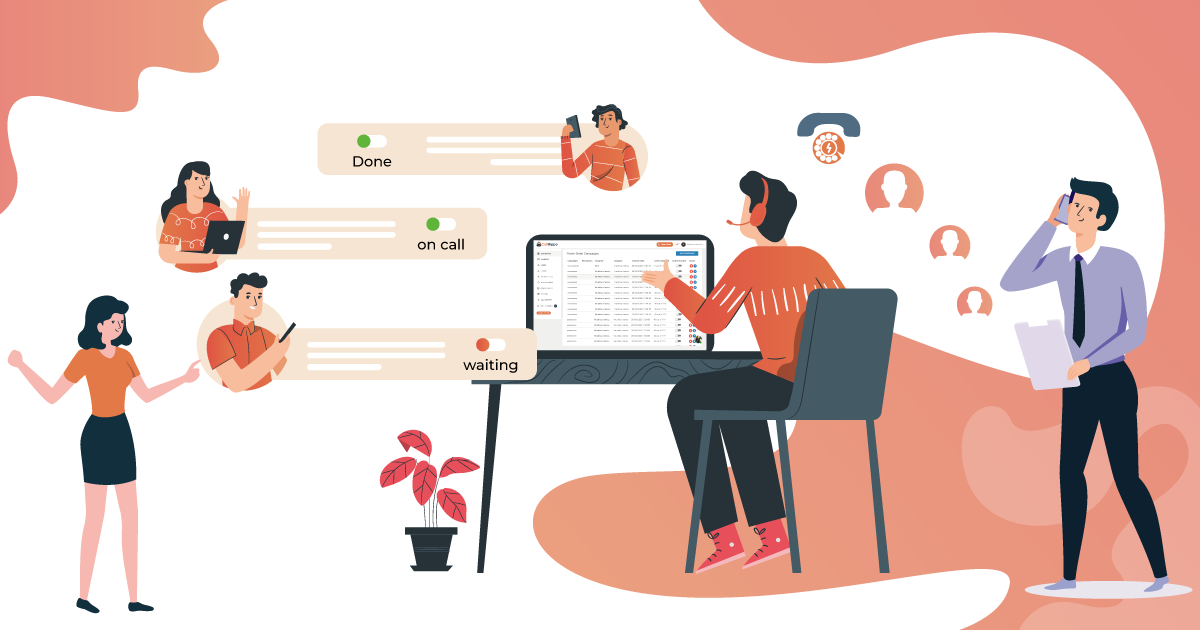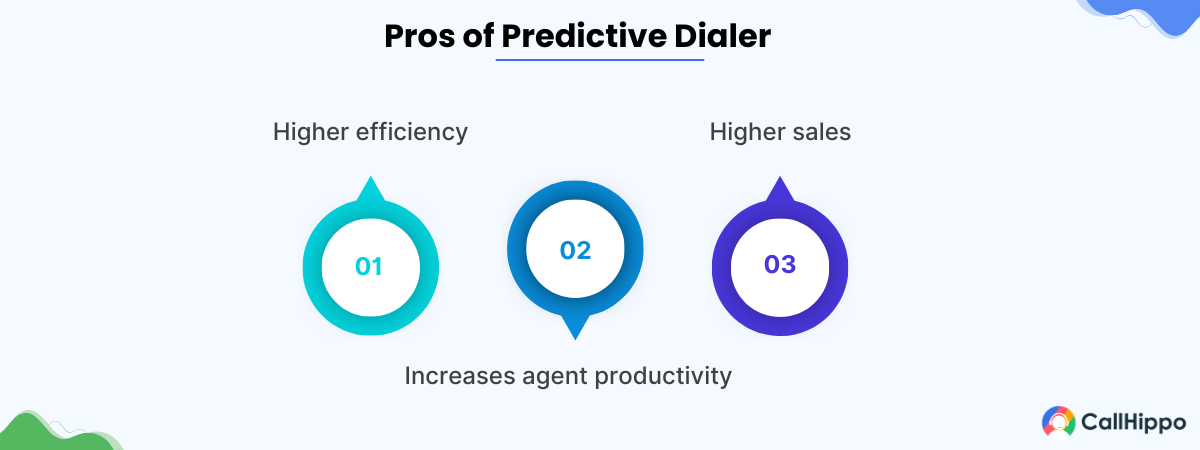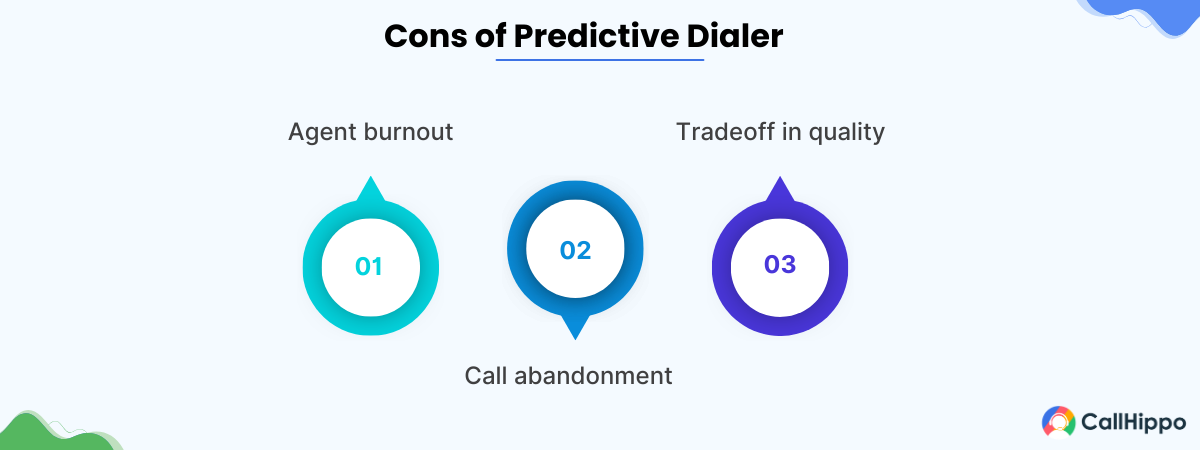In highly competitive & fast-paced business environment, it is important to stay on top of emerging technologies. Auto dialers are rapidly evolving and have received a warm welcome from businesses as they help boost agent productivity by 200-300%.
Progressive and predictive dialers are important auto-dialers that help automate outbound calls and optimize the reach of outbound sales campaigns. Knowing the key attributes of a predictive dialer vs. a progressive dialer helps businesses make the right choice for their campaigns.
What Is a Predictive Dialer?
A predictive dialer is an automated dialing feature that calls contacts until a connection is detected and then routes the call to an agent. It helps reduce agent idle time and enables them to make more sales calls in less time.
Predictive dialers are a defining feature of cloud communications-based phone systems and they help enhance the efficiency of outbound sales campaigns.
In the predictive dialing process, dialers automatically filter out unproductive calls, voicemails, busy tone signals, and unanswered calls. Doing so helps enhance agent utilization and save them from burnout. As the process of selecting the numbers and dialing is automated, agents can channel their focus on performing core critical tasks. An important aspect of predictive dialer software is that it makes multiple outbound calls at a time.
Predictive dialer software solutions use pacing algorithms that use call metrics to estimate the agent availability and alter its dialing speed. For instance, if the agents are unavailable or overworked, then predictive dialers slow down or stop dialing.
"Understanding the key attributes of predictive dialer vs. progressive dialer is essential for businesses as the dialer choice impacts campaign outcomes. Predictive dialers are ideal for high-volume B2C campaigns while progressive dialers work well for B2B outbound campaigns. "
What Is a Progressive Dialer?
A progressive dialer is commonly found in outbound call centers and automates the dialing process so agents don’t have to manually pick and dial numbers from their contact lists. Progressive dialers wait for an agent to complete the previous call before making the next call.
Progressive dialers place one call per agent at any point in time. Every time an agent finishes a call, the dialer will pick the next contact and start dialing. As the agent is readily available to handle the call as soon as it is picked up, it reduces abandonment rates.
Here, the dialer makes progressive calls and the supervisors can control the duration of intervals between the outbound calls.
How Do Predictive Dialers Work?
Predictive dialers use exhaustive algorithms to predict the availability of sales reps and route calls accordingly.
Here is how predictive dialer software systems work.
1. The dialer uploads the contact list with the phone numbers of people that must be reached.
2. The dialer picks the numbers from the list and starts calling them. If the call ends up being unanswered, with a busy tone, or transfers to the voicemail, then the dialer will tag the number accordingly and move to dial the next number.
3. When the call is picked up by a human, the dialer routes the call to the sales representative who will move ahead with the pitch.
4. The process continues until it completes dialing all the numbers in the list.
5. In the predictive dialing process, dialers use call duration, abandonment rate, etc. to build the call pacing algorithm. They also use other metrics that include,
- What is the average call-handling time for an agent/ department? How long does it take for them to complete a call successfully?
- On average, how many calls the dialer has to make to reach a human agent and engage in productive sales conversations?
- If the calls are not immediately routed to the sales reps, what is the call abandonment rate?
- How many agents are available for the next call?
By using the data, the algorithm computes appropriate pacing to ensure that the outbound calling campaign reaches more people without burdening the agents.
You May Also Read : Auto Dialer Software For Your Call Center
How Do Progressive Dialers Work?
The progressive dialer works similarly to predictive dialers, but the only difference is that it starts dialing only when an agent completes the ongoing call.
Progressive dialers do not predict when an agent will be available, instead they progressively utilize agent availability. This is an important attribute of predictive vs, progressive dialers.
Here’s a step-by-step working of progressive dialers.
- First, the outbound contact center provides the dialer with a customer or lead database for the campaign.
- Before making a call, progressive dialers ensure that an agent is available. It only dials one call per agent.
- It initiates the next call only after an agent completes the ongoing call.
- Once a call is picked up by a human, the dialer routes it to the agent who makes the sales pitch.
- After the call ends, the agent can attach tags and make notes for future reference.
- Agents can indicate their availability to take the next calls, so they gain more control over the process. Supervisors can also set the interval duration between each call.
Which Dialer Is Right for Your Business?

When we evaluate the features and abilities of predictive dialers vs progressive dialers, it is clear that each of them has its pros and cons. Choosing a sales dialer depends on the needs of your business and the objectives of your outbound calling campaigns.
If you are operating in a regulated industry that treats abandoned calls, then a progressive dialer works best. It is also ideal if you deal with high-touch services that require a personalized sales pitch. With progressive dialers, agents get some time to go through notes, customer information, and conversational history in between calls.
On the other hand, if your priority is enhancing the efficiency of your outbound campaign or boosting the agent utilization rates, then predictive dialer software solutions are appropriate. They help accelerate the pace of campaigns, so predictive dialers are the right option if you want to reach as many contacts as possible in a short duration.
You May Also Read : 11 Best Free Auto Dialer Software
Pros and Cons of Predictive Dialer
Understanding the pros and cons of a predictive dialer is essential for a comprehensive analysis of a predictive dialer vs. progressive dialer.
Pros
The following are the pros of using predictive dialer software for outbound campaigns.

1. Higher efficiency
Using predictive dialers helps agents reach out to more contacts during a period and make a sales pitch. The increased call rates help businesses improve their efficiency.
2. Increases agent productivity
Predictive dialers help reduce idle time and promote higher utilization as they automate the process of initiating a call. The agent productivity improves as the predictive dialers make multiple calls simultaneously.
3. Higher sales
As predictive dialers automate the process of dialing and making calls, agents can focus their effort and time on talking to leads and delivering a quality pitch. Predictive dialers can also be configured to screen unproductive calls, so they can engage in fruitful conversations with sales-qualified leads.
Cons

1. Agent burnout
As the basic idea of predictive dialers is to enhance agent utilization and boost call rates, there is very little or no time between calls. This leads to agent burnout.
2. Call abandonment
Sometimes, predictive dialer software systems may reach out to prospects and have them waiting even before an agent becomes available. In these cases, customers abandon the call after waiting for a while.
3. Tradeoff in quality
While predictive dialers focus on reaching out to more contacts in less time, there is more emphasis on quantity. With overworked agents, there may be a loss in the quality of the sales pitch impacting the outcomes.
Pros and Cons of Progressive Dialer
Unlike predictive dialers that initiate the call and then route the productive ones to the available agent, progressive dialers start dialing only after an agent becomes available. Here are its pros and cons.
You May Also Read : Power Dialer Pricing: Maximizing Value for Your Investment
Pros
1. Lower abandonment rates
A deeper analysis of a predictive dialer vs. a progressive dialer shows that the latter carries lower abandonment rates. With progressive dialers, you have an agent waiting online to engage with the prospects. This reduces abandonment rates.
2. Lower agent burnout
As agents get more space in between calls, they do not feel overworked, unlike predictive dialers.
3. High-quality interactions
Progressive dialers offer more time for agents to review customer information and history. This helps them customers, a personalized conversational experience.
Cons
1. Lower agent utilization
When compared to predictive dialers, there is lower agent utilization with progressive dialers as they wait for the agent to become available to initiate a call.
2. Slower dialing rates
The rate of dialing is slow with progressive dialers and this makes it inefficient for use in large-scale campaigns.
A Forbes study shows that sales representatives spend 64.8% of their time on administrative tasks. With predictive dialers and progressive dialers, a considerable amount of their time and effort spent on repetitive tasks gets saved.
Closing Thoughts
While there is no simple answer to the question of predictive dialer vs. progressive dialer, choosing the right call center dialer decides the effectiveness of your outbound sales campaigns. Overall, if you aim to reach as many contacts in a given time, then a predictive dialer software is the ideal.
On the other hand, if you intend to make high-quality, personalized interactions with qualified leads, then you must go with progressive dialers.
FAQs:
1. What is the difference between a predictive dialer and an autodialer?
A predictive dialer is an autodialer but the difference is that auto dialers cannot predict or calculate agent availability. Auto dialers dial the next number after an agent becomes available, whereas predictive dialers can adjust the dialing rate based on agent availability.
2. What are the different types of dialers?
There are various types of dialers for businesses to enhance the effectiveness of their outbound campaigns. They include,
- Auto dialer
- Predictive dialer
- Power dialer
- Progressive dialer
- Preview dialer.
3. What is a 3-line dialer?
A 3-line dialer dials three lines simultaneously from the contact list and routes the answered calls to the available agents.
4. What is the difference between a single-line and a triple-line dialer?
A single-line dialer dials only one number at a time, while a triple-line dialer can dial three numbers simultaneously. Triple-line dialers are more productive as they help reach more prospects during a given period.

Subscribe to our newsletter & never miss our latest news and promotions.









